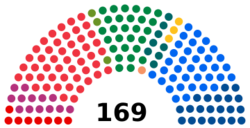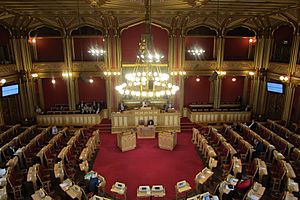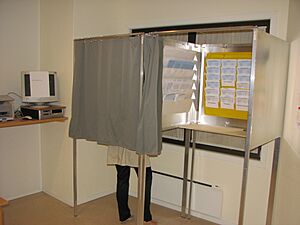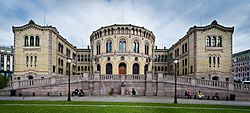Storting facts for kids
Quick facts for kids Parliament of NorwayStortinget |
|
|---|---|
| 166th Storting | |

|
|
| Type | |
| Type | |
|
Term limits
|
4 years |
| Established | 1814 |
| Leadership | |
|
President of the Storting
|
Masud Gharahkhani (Labour)
|
|
Svein Harberg (Conservative)
|
|
|
Nils T. Bjørke (Centre)
|
|
|
Morten Wold (Progress)
|
|
|
Kari Henriksen (Labour)
|
|
|
Ingrid Fiskaa (Socialist Left)
|
|
| Structure | |
| Seats | 169 |
 |
|
|
Political groups
|
Government (48)
Supported by (41)
Opposition (80)
|
| Committees |
|
| Elections | |
| Open list proportional representation Modified Sainte-Laguë method |
|
|
Last election
|
13 September 2021 |
|
Next election
|
8 September 2025 |
| Meeting place | |
 |
|
| Hemicycle of the Parliament of Norway Building Oslo, Norway |
|
| Constitution | |
| Constitution of Norway | |
The Storting (which means "the Great Assembly" in Norwegian) is the main law-making body of Norway. It was created in 1814 by the Constitution of Norway. The Storting is located in Oslo, the capital city.
This parliament has 169 members. These members are chosen every four years. They are elected based on a system called party-list proportional representation. This means that parties get seats in the Storting based on the percentage of votes they receive.
The Storting is led by a President and five Vice Presidents. Together, they form the presidium. The members also work in different groups called standing committees. These committees focus on specific topics.
Since 1884, Norway has used a Parliamentary system. This means the government needs the support of the Storting to stay in power. For a long time, the Storting worked like a two-part parliament, with an "upper house" called the Lagting and a "lower house" called the Odelsting. However, this system was changed in 2007. Since the 2009 election, the Storting has been a single, unified parliament.
After the 2021 Norwegian parliamentary election, ten different political parties have members in the Storting. These include the Labour Party, the Conservative Party, and the Centre Party. The current President of the Storting, since 2021, is Masud Gharahkhani.
Contents
How the Storting Began
The Storting, as we know it today, was first formed in 1814. This happened at a place called Eidsvoll. However, the idea of a public assembly in Norway is much older. It goes back to the 9th century with meetings called alltings.
These alltings were common gatherings of free men. They would meet in special places called "thingsteads." Here, they would talk about laws and important political matters. Over time, these meetings became more formal. They grew into larger regional gatherings.
Later, in the 13th century, older regional assemblies were combined. King Magnus Lagabøte helped write down the laws. This legal system was important until 1660. That's when King Frederick III declared absolute monarchy. This meant the king had all the power. This system lasted until 1814, when the Storting was created.
The building where the Parliament of Norway meets opened in 1866.
The Storting During World War II
During World War II, Norway was occupied by German forces. In September 1940, members of the Storting met in Oslo. They discussed how to deal with the situation. Some members voted to cooperate with the occupation authorities. However, the German leader, Adolf Hitler, stopped this agreement.
How the Storting Changed Over Time
From 1814 until 2009, the Storting worked in a special way. Even though it was technically one parliament, it acted like it had two parts. After an election, one-fourth of the members would form the Lagting. This was like an "upper house" that reviewed laws. The other three-fourths formed the Odelsting, the "lower house."
The main idea in 1814 was for the Lagting to be a more experienced group. However, over time, the Lagting usually agreed with the Odelsting. So, passing a bill through the Lagting became mostly a formality.
Bills, or proposed laws, were usually started in the Odelsting. Members of the Lagting could not propose laws on their own. A special committee, with members from both parts, would then look at the bill. If the Odelsting approved a bill, it went to the Lagting for review. Most bills were passed by the Lagting without changes. Then, they were sent to the King for his approval.
If the Lagting changed a bill, it went back to the Odelsting. If they still disagreed, the bill would be voted on by all members of the Storting together. To pass, it needed approval from two-thirds of the members. For other matters, like taxes, all members met together.
In 2004, a plan was made to change the constitution. This plan was to get rid of the Odelsting and Lagting. The Storting approved this change on February 20, 2007. It officially started with the new Storting elected in 2009.
Number of Members in the Storting
The number of members in the Storting has changed over the years.
- In 1882, there were 114 members.
- By 1921, it increased to 150.
- In 1973, it became 155.
- Since 2005, the Storting has had 169 members.
How Laws Are Made
Making New Laws
Making a new law in Norway involves five steps:
- Step 1: Idea for a Bill A new law, called a bill, is suggested. This can be by a government member or any elected representative.
- Step 2: Committee Review The Storting sends the bill to a special committee. This committee studies the bill in detail.
- Step 3: First Vote The Storting debates the committee's suggestion and takes a first vote. If the bill is rejected, it stops here.
- Step 4: Second Vote At least three days later, the Storting debates the bill again. A second vote is taken. If it passes, it goes to the King for approval.
- Step 5: Third Vote (if needed) If the Storting changes its mind during the second vote, a third vote happens. This is also at least three days later. The Storting can then approve the changes or reject the bill completely.
The King's Approval
Once a bill passes the Storting, it goes to the King. The King must sign the bill. The Prime Minister also signs it. After this, it becomes a law in Norway. The law starts on the date mentioned in the document or decided by the government.
The Norwegian constitution gives the King the power to say "no" to a bill. However, no Norwegian King has used this power since 1905. If a King were to use this power, the Storting could still make the bill a law. This would happen if the Storting passed the same bill again after a new election.
How the Storting is Organized
The Presidium
The presidium is the leadership team of the Storting. It is led by the President of the Storting. It also includes five Vice Presidents. This system with five Vice Presidents started in 2009. Before that, there was only one Vice President.
| Position | Representative | Party |
|---|---|---|
| President | Masud Gharahkhani | Labour |
| First Vice President | Svein Harberg | Conservative |
| Second Vice President | Nils T. Bjørke | Centre |
| Third Vice President | Morten Wold | Progress |
| Fourth Vice President | Kari Henriksen | Labour |
| Fifth Vice President | Ingrid Fiskaa | Socialist Left |
Standing Committees
Members of the Storting work in twelve standing committees. Eleven of these committees focus on specific topics, like education or health. The twelfth is the Standing Committee on Scrutiny and Constitutional Affairs. Each committee's work matches the responsibilities of one or more government ministers.
| Committee | Chair | Chair's party |
|---|---|---|
| Business and Industry | Geir Pollestad | Centre |
| Education, Research and Church Affairs | Roy Steffensen | Progress |
| Energy and the Environment | Ketil Kjenseth | Liberal |
| Family and Cultural Affairs | Kristin Ørmen Johnsen | Conservative |
| Finance and Economic Affairs | Mudassar Kapur | Conservative |
| Foreign Affairs and Defence | Anniken Huitfeldt | Labour |
| Health and Care Services | Geir Jørgen Bekkevold | Christian Democratic |
| Justice | Lene Vågslid | Labour |
| Labour and Social Affairs | Erlend Wiborg | Progress |
| Local Government and Public Administration | Karin Andersen | Socialist Left |
| Scrutiny and Constitutional Affairs | Dag Terje Andersen | Labour |
| Transport and Communications | Helge Orten | Conservative |
Other Important Groups
There are also other important groups in the Storting.
- The Enlarged Committee on Foreign Affairs talks about important international matters with the government. These discussions are kept private.
- The European Committee discusses matters related to the European Union with the government.
- The Election Committee helps with internal elections in the Storting. It also decides how members are placed in committees.
- The Preparatory Credentials Committee checks and approves the election results.
Agencies Appointed by Parliament
Five public agencies are chosen by the Storting, not by the government.
- The Office of the Auditor General checks how public money is spent.
- The Parliamentary Ombudsman helps people with problems they have with public services.
- The Ombudsman for the Armed Forces helps people in the military.
- The Ombudsman for Civilian National Servicemen helps people doing civilian service instead of military service.
- The Parliamentary Intelligence Oversight Committee watches over intelligence and security services.
The Storting also chooses the five people who decide the Nobel Peace Prize.
How the Storting is Managed
The Storting has about 450 people who help run it. This team is led by the Director of the Storting, Marianne Andreassen, who started in 2018. She also works as a secretary for the presidium.
Political Party Groups
Each political party with members in the Storting has its own group. This group is led by a parliamentary leader. Often, the party leader is also the parliamentary leader. However, if a party leader is a government minister, another representative usually takes on the role of parliamentary leader.
| Party | Seats | Parliamentary leader |
|---|---|---|
| Labour Party | 48 | Rigmor Aasrud |
| Centre Party | 28 | Marit Arnstad |
| Conservative Party | 36 | Erna Solberg (also party leader) |
| Progress Party | 21 | Sylvi Listhaug |
| Socialist Left Party | 13 | Kirsti Bergstø (also party leader) |
| Red Party | 8 | Marie Sneve Martinussen (also party leader) |
| Liberal Party | 8 | Terje Breivik |
| Green Party | 3 | Arild Hermstad (also party leader) |
| Christian Democratic Party | 3 | Hans Fredrik Grøvan |
| Patient Focus | 1 | Irene Ojala (also party leader) |
How Members Are Elected
Members of the Storting are chosen using a system called party-list proportional representation. This means that different political parties get representatives from each voting area. These voting areas are the same as Norway's 19 former counties. Even though some counties have merged, the election areas remain 19.
When people vote, they don't vote for individual people. Instead, they vote for a party's list of candidates. The person at the top of the list usually gets the seat. However, voters can sometimes change the order on the ballot. Parties can even suggest candidates from outside their own voting area. Norwegians living abroad can also be candidates.
The Sainte-Laguë method is used to give seats to parties. This system tries to make sure that the number of representatives a party gets is close to its total percentage of votes across the country. However, a party can still win a seat in one area even if it has a low percentage of votes nationwide.
Elections for the Storting happen every four years. They are usually held on the second Monday of September. Unlike many other parliaments, the Storting always serves its full four-year term. The Constitution does not allow early elections. If a member cannot serve, a backup representative from the same party takes their place. This means that special elections to fill empty seats are rare.
Norway changed its election system in 1919. Before that, members were chosen from single areas.
Members of the Storting
The Storting has 169 members. If a member cannot do their job, for example, if they become a government minister, a deputy representative steps in. This deputy is the next person on the party's list from the last election.
In the main meeting room, members sit in a half-circle shape. Government ministers sit in the front row. Behind them, members of parliament sit based on the county they represent, not by their political party.
The Parliament Building
Since March 5, 1866, the Storting has met in the Parliament of Norway Building. This building is located at Karl Johans gate 22 in Oslo. A Swedish architect named Emil Victor Langlet designed it. The building is made of yellow brick with light gray granite details. It mixes different architectural styles, with ideas from France and Italy.
The main Parliament building is not big enough for all the staff and members today. So, the Storting also uses offices and meeting rooms in other buildings nearby. These include buildings on Akersgata, Prinsens Gate, Tollbugata, and Nedre Vollgate.
Images for kids
See also
 In Spanish: Storting para niños
In Spanish: Storting para niños





